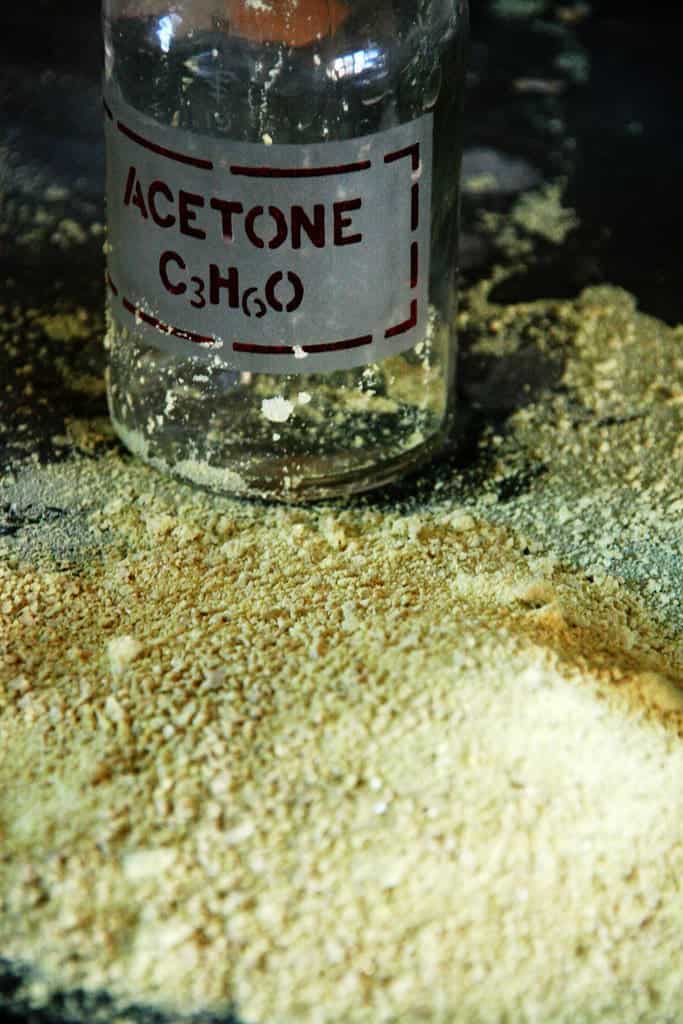The two most popular organic solvents used for cleaning and thinning applications are acetone and methyl ethyl ketone (MEK).
Two typical organic solvents, acetone and MEK, can dissolve resin and ethylene vinyl acetate in a polar solvent like ethanol. Acetone and MEK both have low vapour pressure and low water solubility.
They both possess the characteristics of a ketone and are strong chemical solvents with no color. Although it is thought that they can be used interchangeably because they can both be used as cleaners and solvent thinners, they are not the same.
Acetone and MEK vary in that Acetone evaporates more quickly because of weaker intermolecular interactions. MEK, on the other hand, evaporates more slowly.
Key Takeaways
- Acetone is a colorless, volatile liquid used as a solvent and a cleaning agent, while MEK is a stronger industrial solvent.
- Acetone evaporates more quickly and is less toxic than MEK.
- MEK can dissolve a wider range of materials and is more effective for removing stubborn residues, such as adhesives and paints.

Acetone vs MEK
These both are cleaning agents, but MEK (methyl ethyl ketone) is stronger than acetone. It evaporates more slowly than acetone and has a higher boiling point as compared to acetone. Acetone is more soluble than MEK and is also more evaporating. Acetone is less expensive as compared to MEK.
Comparison Table
| Parameters of comparison | Acetone | MEK |
|---|---|---|
| Toxicity | Less | Strong and more |
| Evaporation rate | High | slow |
| Boiling point | Low | High |
| Cleaning agent | Less strong (weak) | More potent and powerful |
| Chemical formula | C3H6O | C4H8O |
What is Acetone?
Acetone is a colorless, highly flammable liquid with a sweet, fruity odour and a strong taste. It has been discovered to be cytotoxic to cells in cultures with high turnover rates, such as cancer cells in vitro and white blood cells in vivo.
It is a carbon, hydrogen, and oxygen-containing organic molecule. It is a ketone or carboxylic acid that can be found in the air.
Acetone can be used to dissolve or deactivate the binding components in adhesives and sealants, but it is not an adhesive in and of itself. Acetone, which is normally clear and colorless, is the dry chemical used in various types of extinguishers.
Acetone, sometimes called dimethyl ketone or propanone, is a common ingredient in domestic goods, including cosmetics and personal care items. It is a substance used to remove varnish, lacquer, and paint. Most of the time, it goes into creating nail polish removers.
It is the most basic Ketone, traditionally created through the destructive distillation of acetic acid and acetates. 1832 Jean-Baptiste-Andre’ Dumas and Justus von Liebig discovered the proper formula. Acetone has been in use since 1839.

What is MEK?
MEK is a fast-evaporating liquid solvent found in printing inks, adhesives, and surface coatings. It is a white liquid solvent that is highly volatile and related to acetone. It has a strong acetone-like odour and is sweet. MEK is commercially produced from n-buttes in a metal-catalyzed hydrogenation reaction via a fast 2-butanol formulation. It is a frequent component in varnishes and glues. It is employed as a component of a mixture of organic solvents. It is found in a vast array of natural products.
Methyl ethyl ketone has proven to be the most adaptable of all organic solvents. It is a dry, odourless solid, clear to pale yellow in color, highly water-repellent, and inflammable. Methyl ethyl ketone is frequently used as a cleaning solvent in industrial settings to remove grease and oil from surfaces and dissolve certain compounds.
MEK is a versatile industrial chemical frequently used to clean thin polyester resins and gel coatings. It is found in industrial settings and popular household products like adhesives.
Methyl ethyl ketone is an excellent chemical for those who love to produce perfumes since it has a special blend of powerful and sweet flavours.

Main Differences Between Acetone and MEK
The main difference between Acetone and MEK is in Water Solubility – Acetone and MEK are both water-soluble chemical molecules. However, because acetone has a low boiling point, it is easier to evaporate for concentration and solvent exchange. Meanwhile, MEK has a higher boiling point, making it a more potent and effective cleaning agent.
The main difference between acetone and MEK is its Toxicity – Acetone, and MEK are both low-VOC solvents, making them less poisonous and safe for usage when kept according to certain guidelines. However, MEK is a chemical widely used in both industrial and consumer goods, including paints, inks, adhesives, cleaning products, dewaxing agents, and protective coatings. The Environmental Protection Agency (EPA) has classed MEK as a highly toxic, ignitable dangerous material since it is more potent than acetone.
The main difference between acetone and MEK is its Evaporation Rate: The rate at which a material will vaporize in comparison to the vaporization rate of a reference substance under identical conditions is known as the evaporation rate. MEK is able to maintain a steady boil when combined with water because it evaporates at a slower pace than acetone.
